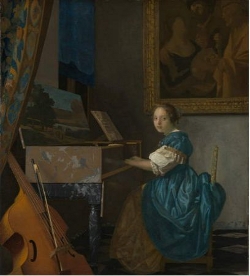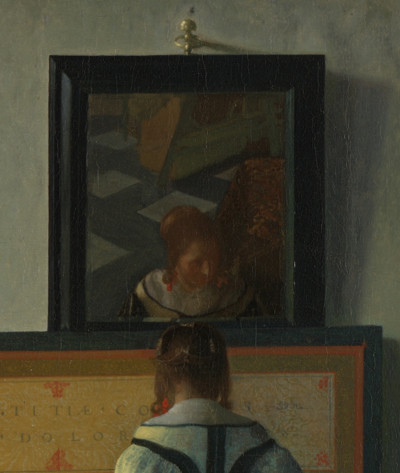Nicholas van Assendelft - "a damsel playing on the Clavichord by Vermeer"
The description of Vermeer's painting in Van Assendelft's collection could fit either A Lady Seated at a Virginal or A Lady Standing at a Virginal, both in The National Gallery of London.
It is not known if Van Assendelft acquired the painting from Vermeer himself. On the other hand, the artist may also have painted yet another damsel at a spinet which no longer exists.

Johannes Vermeer
c. 1670–1673
Oil on canvas, 51.7 x 45.2 cm.
National Gallery, London

Johannes Vermeer
c. 1670–1675
Oil on canvas, 51.5 x 45.5 cm.
National Gallery, London
Willem van Berkel - "Jupiter, Venus and Mercury"
"In 1716 a now-lost history painting from the beginnings of Vermeer's career, called "Jupiter, Venus and Mercury, by J. ver Meer," was auctioned from the estate of Delft patrician Willem van Berckel (c. 1620–1686). The collection had been formed earlier in the century by Gerard van Berckel, a one-time burgomaster of the city of Delft. "This mythological scene, presumably in the possession of the distinguished Delft family for a long time, may be considered evidence of the interest in Vermeer's work in the upper echelons of Delft society."Arthur K. Wheelock Jr., "Johannes Vermeer," in Johannes Vermeer, eds. Arthur K. Wheelock Jr. and Ben Broos (London; New Haven: Yale University Press, 1995), 55.
Initially, John Michael Montias held that with "Diana and her Companions represented "Vermeer's only foray into mythology since "Jupiter, Venus and Mercury do not appear jointly in any know subject drawn from mythology. Perhaps the auctioneer mistook the female figure for Venus, when it actually represented Virtue or Psyche. Dosso Dossi's painting of Jupiter, Mercury and Virtue (shown as a female figure) is conserved in Vienna. Raphael is known to have made a drawing of Mercury introducing Psyche to Jupiter."John Michael Montias, 00 (Princeton, NJ: Princeton University Press, 1989), 140.
However, Michiel C. Plomp revealed "a drawing by [Leonaert] Bramer after a painting by Jacob Jordaens, the subject of which is taken from the legend of Psyche in Apuleius's Golden Ass. It shows a jealous Venus complaining to Jupiter, in Mercury's presence, about Psyche's charms. This unpublished drawing...was once part of the album of about 110 drawings made by Bramer after paintings that belonged to Delft collectors in 1652–1653. It is quite possible… that Vermeer had seen the Jordaens painting not long before he painted his own version of the subject (presumably before 1656, the date of The Procuress, his first genre painting). The Jordaens composition would have appealed to his own interest in women attending, or deferring to, men (as in Christ in the House of Martha and Mary)."John Michael Montias, "A Postscript on Vermeer and His Milieu," Mercury (1991).
The young and ambitious Vermeer may have painted this mythological scene in order to cater to the classical tastes of the Dutch court in the rich and nearby The Hague. The painting appeared in the Delft auction on March 24, 1761.
Cornelezoon de Helt - "painting in a black frame"
Little can be deduced from the meager description of the "painting in a black frame" by Vermeer. Vermeer, like many other Dutch painters, used black (ebony or ebonized) frames a few of which hang on the back walls in his own compositions. Ebony frames were also used for mirrors. Dutch frame-makers were known for their ability to imitate costly exotic woods. Incidentally, the husband of Vermeer's sister was a framemaker.

Johannes Vermeer
c. 1662–1665
Oil on canvas, 73.3 x 64.5 cm.
The Royal Collection, The Windsor Castle
Diego Duarte - "a small painting with a lady playing the clavecin, with accessories, by Vermeer"
Diego Duarte was an immensely wealthy Antwerp jeweler and banker. "It is suggestive that Duarte maintained contact with Holland through Constantijn Huygens the Younger, who, like Johan Larson [a sculptor who purchased a tronie head from Vermeer] lived in The Hague. Duarte's father had a clavecin made for Huygens, and Duarte corresponded with Huygens about music. He also was an accomplished organist and composer. With the musical interests it is appropriate that Duarte's Vermeer represented in his inventory number 182, "a small painting with a lady playing the clavecin, with accessories."Albert Blankert, with contributions by Rob Ruurs and Willem van der Watering, Vermeer (Oxford: Phaidon, 1978). Duarte's picture was valued at 150 guilders.

Johannes Vermeer
c. 1670–1675
Oil on canvas, 51.5 x 45.5 cm.
National Gallery, London